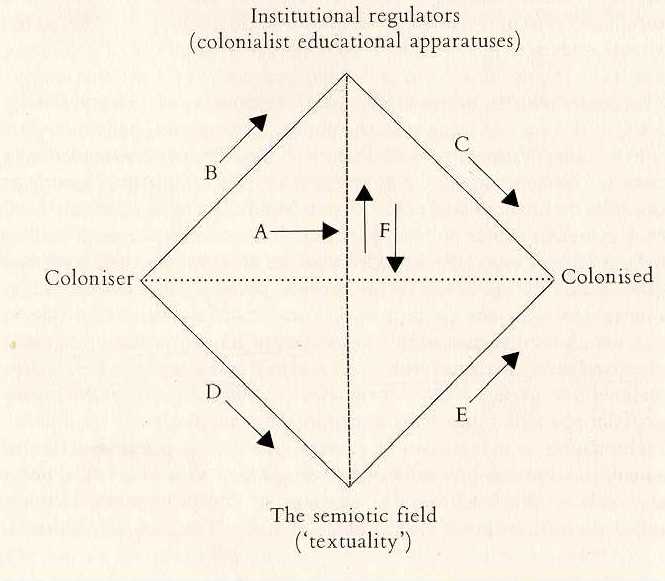Colonial Hegemony and The Problem of Cultural Representation The following diagram seeks to set forth the effect that colonial politics and education (among other institutions) had on the mindset and self-perception of those cultures which were colonized. Imagine what happens when a people are not only shaped by the experience of direct political control, but also by the messages they receive in their education and even their popular media. What would it be like to continually encounter from all directions the implication that you are inferior? |
 |
| "Institutional regulators" signifies the
means of cultural education that the dominant oppressor culture has instituted. This
includes schools, churches, clubs and organizations, businesses--any organization that
teaches what is and is not known, accepted, and understood as cultural givens. "The semiotic field" signifies methods of cultural representation -- books, music, portraits, popular images and icons, theatre, etc. These are the officially sanctioned arts. A represents the direct political power and control a dominant group has over an oppressed group. B and C represent the way a dominant group shapes an oppressed group's social standing, intellectual advancement, even self-perception through a control of what is acceptable knowledge and behavior. D and E represent how cultural representation also shapes an oppressed group by perpetuating certain behaviors and images of a people. F represents the reciprocal relationship between those institutions of cultural education and those expressions of cultural representation.
What this diagram doesn't express are the ways in which the colonized, the oppressed, resist this education and representation. These methods tend to take on three different manifestations:
One of the best examples of this is jazz. Jazz itself is a form of music that arises out of the mixture of traditional African music, the blues, and ragtime. It pulls together European instrumentation with African rhythms and improvisation. Arising as it did in the 20th century, its practitioners have had to struggle with how to understand its relationship to the black community and to the larger multi-ethnic experience of the United States. Critics have differed, for example, over whether Louis Armstrong played to or subverted white audiences' expectations for the "Uncle Tom" behavior of the black male. The elegance of Duke Ellington, on the other hand, chose to respond to audience expectations in a completely different way. Both can be seen as authentic or compromised, depending on the critic. Ellington's move to larger, more complex compositions (which included the use of European-style classical borrowings) was also condemned and praised. Some African-American musicians in jazz sought to create a music that valorizes black accomplishments and disdains white involvement. Others, such as Thelonious Monk or Charlie Parker (both strong activists in their own way) incorporated European Modernists like Stravinsky into their own compositions. |